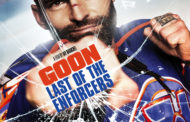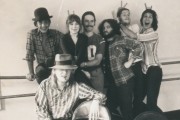 When I was in high school, my preferred method of learning history was through political cartoons. This isn’t just because I’m a lifelong fan of comics in any form, but it is also because a political cartoon expresses then-current opinions on issues of the day, unlike history books with decades of hindsight. In addition, the best political cartoonists have been wickedly clever, with far more teeth than Stephen Colbert or Jon Stewart (who appears in this documentary) on their best nights.
When I was in high school, my preferred method of learning history was through political cartoons. This isn’t just because I’m a lifelong fan of comics in any form, but it is also because a political cartoon expresses then-current opinions on issues of the day, unlike history books with decades of hindsight. In addition, the best political cartoonists have been wickedly clever, with far more teeth than Stephen Colbert or Jon Stewart (who appears in this documentary) on their best nights.
Among the greatest of America’s political cartoonists is Herbert Block, better known by his pen name Herblock. Herblock is perhaps only eclipsed by Thomas Nast and Bill Mauldin as the United States’ greatest political cartoonist, though Herblock was undoubtedly one of the masters of the form in the 20th century. His career as a cartoonist started during the Herbert Hoover administration, and upon landing at The Washington Post he worked until his death during George W. Bush’s first term. Herblock’s cartoons were not just a feature in the paper, oftentimes they WERE the paper, frequently calling out the current president or other political figures. His work is fascinating, and director Michael Stevens (who has either directed or produced dozens of live political events, including the Kennedy Center Honors from 2003 to current and Christmas in Washington from 1994 to 2011) has chosen a remarkable subject for his documentary Herblock: The Black & The White. Unfortunately, in making his first documentary feature he forgot about doing the subject justice.
Herblock is a fascinating subject on his own, so I was perplexed by some of Stevens’ decisions that drew focus away from the man himself. The primary way he did this was by trying to “resurrect” Herblock by portraying an interview with him as the film’s main narrative thread with a lookalike actor playing Herblock (more on this in a bit). Another odd choice is filling the film with music, even when completely inappropriate. There are many scenes in which there is loud, dramatic music that builds to patriotic crescendos and flailing trumpets. In fact, there are few moments of the film that are not filled with music, and I’m not sure why Stevens didn’t just stick with silence instead of bombarding the audience with overdramatic music cues that distracts rather than highlights Herblock’s work. Additionally, toward the end of the film there is a focus on the sad state of journalism and how journalism today can learn from Herblock. While this is obviously true, it drifts from the focus on the subject. In particular, it’s a huge oversight to gloss over Herblock’s criticisms of Kennedy, Ford, and Bush Sr. — who are hardly mentioned at all in the documentary — when every other president during Herblock’s professional career gets a few moments of focus (even George W. Bush gets a segment, though Herblock only did a small fraction of his work on him). Also, the handful of cartoons criticizing Herblock’s hero FDR — especially for his plan to radically change the Supreme Court — go unmentioned despite being among Herblock’s most famous earlier cartoons and proof that Herblock didn’t play favorites. Finally, the documentary seems to go out of its way to present Brit Hume of Fox News as some kind of wackadoo because he suggests Herblock was overly critical of conservatives — yet other talking heads in the documentary fully support Hume’s points! Why try to make Hume, a respected journalist regardless of whom he works for, look bad when he’s simply being more assertive than his colleagues who agree with his point?
But the first issue is the documentary’s cardinal sin. I was bothered by the deception of the “Herblock” interviews, particularly at the very end when “he” speaks to the audience directly about his views on government. Yes, Herblock died in 2001, but he left a lifetime of work to speak for him. Unless I missed it, there was no title card at the beginning of the film to indicate that actor Alan Mandell would be “playing the role” of Herblock in these interviews, so anyone who didn’t know otherwise would think these interviews with a lookalike were interviews with the man himself… until the title card appears in the credits. Why go though such a deception? Sure, documentaries often feature others reading the words of famous figures, but I can’t think of any that dress someone up as a virtual double for the deceased and have him speak the relatively recently deceased’s words as if he were a body double filling in for the time being. What an odd, and frankly deceitful, choice!
As a result, while I feel that every schoolchild should learn Herblock’s work (along with Thomas Nast’s and other prominent cartoonists), I can’t recommend Herblock: The Black & The White as an educational tool because of these flaws. If a documentary is supposed to present truth, Stevens failed by disregarding the truth about Herblock in order to present a fantasy version of him for reasons I can’t quite figure out.
RATING: A deeply flawed documentary about a subject who deserved far better (4/10).















Recent Comments